
Peer reviewed journal - published through Research Catalogue, NMH portal
Coup de la Glotte and Voix Blanche
Two vanished techniques of the Garcia School
Ingela Tagil
CONTENTS
Introduction
Materials and method
Short background to the Garcia School
Coup de la Glotte
Larynx position for the Voix Blanche
Conclusion
Manuel Garcia the younger (1805–1906) was one of the most influential singing teachers of the nineteenth century. His teaching is often considered as a bridge between older and newer opera aesthetics in the mid-nineteenth century. He represented the Old Italian School, but he was also a modern researcher. James Stark claims that Garcia was the last great teacher of the virtuosic Bel Canto style. He inherited his vocal aesthetic and technique from his father although he belonged to a new generation who wanted to investigate the physiological factors determining vocal production.[1] The aesthetics of Bel Canto implied fast coloraturas and embellishments varied with beautiful melodies delivered with a bright, brilliant tone quality employing no, or, at least, less vibrato than today. Garcia taught this brilliant, florid style, which had dominated the opera scene for almost200 years,[2] but during his lifetime its popularity declined. Romanticism demanded a new heroic singing style with long dramatic lines which replaced the coloraturas. As orchestras and opera houses grew larger, this required more voice volume and the singers were pushed to invent new techniques in order to be heard.
In response to this demand, singers experimented with breathing techniques and, when abdominal breathing support was introduced, voice volume increased. Tenors experimented with full voice, even in the highest tone range, which created a new archetype of masculinity illustrated by vigorous sounds in high tessituras. Indeed, these emphases upon passion and voice volume impacted all other voice ranges. By the end of the nineteenth century the delicate ornamented style was vanishing and giving way to the voluminous heroic declamatory style, with focus on voice resonance.[3]
Stark claims that Garcia preferred a brighter tone quality to that of voice resonance, even as the latter became fashionable in the late nineteenth and, later, the twentieth centuries. His technique was more attuned to older vocal aesthetics and repertoire, such as Mozart and Rossini, rather than to his contemporaries. The opera examples given in his publications are mainly from Rossini, Donizetti, Bellini, Meyerbeer, Weber, Mozart and Gluck, whereas he accused contemporary composers, such as Verdi and Wagner, of destroying voices by forcing them to sing with ever-increasing vigour and power.[4] David Mason claims, that although his system was more modern, Garcia’s exercises are similar to the seventeenth-century coloratura technique.[5] David Lawton even claims that his rich embellishments were unfashionable for the time.[6] Garcia himself knew that the agility of the vocal school he represented was declining. In his last publication, 1894, he complained that the singers of the new generation did not master the brilliant florid style anymore. He did not like the voluminous declamatory style, which he claimed required more mature voices, and he claimed that the Old Italian School represented the only correct singing technique.[7] Garcia’s texts are precisely formulated - one might say pedantic - which explains the particularly detailed information and technical instructions they contain and the special place his publications occupy as a window into vocal history.
This paper focuses on two of Garcia’s terms, his controversial Coup de la Glotte and the larynx position Voix Blanche. Coup de la Glotte refers to a firm closure of the glottis in the tone onset. This was seen as essential by Garcia, although his definition is complex, difficult to interpret and, since his time, has been criticized, debated, misunderstood, reinterpreted and, finally, has almost vanished from the literature. Critics for a long time condemned Coup de la Glotte as to harsh for the vocal cords and dangerous to the voice. The publication Hints on Singing, 1894, was Garcia’s last attempt to defend and explain what he found as the benefits of the Coup de la Glotte.[8]
Today’s researchers still have different opinions of this tone-onset technique. Miller and Mason associate it with an explosive sound similar to a coughing.[9] Meanwhile Stark, Stephen Austin and Robyn Cathcart stress that Garcia’s choice of words was unfortunate. The word “coup” suggests violence and that was probably not his intension.[10] Stark claims that even those among Garcia’s contemporaries who believed in the Coup de la Glotte mistook it for a simultaneous onset and therefore Garcia’s original idea disappeared.[11]
The term Voix Blanche means a higher larynx position than used in opera singing today. It is the opposite of the fixed lowered larynx, which Garcia termed Voix Sombre. According to Mason, the fixed lowered larynx is universal in today’s opera houses,[12] while both the Coup de la Glotte and Voix Blanche are extinct. This paper does not aim to either advocate or condemn the Coup de la Glotte or Voix Blanche. Its purpose is to determine what Garcia actually intended and to find out how these vanished techniques affect the voice and timbre of high sopranos and coloratura sopranos.
Materials and method
The materials used consist of three elements. Firstly, Garcia’s publications: Garcia’s New Treatise of the Art of Singing (1872),[13] “Observations on the Human Voice” (1855)[14] and Hints on Singing (1894).[15] Garcia’s Traité de l’Art du chant (1847) is from Donald V. Paschke’s reprinted publication.[16]
The second resource consists of recordings from the Garcia/Marchesi School made before 1910. The only recording presented here is from the Marchesi student Nellie Melba (1861–1931) who sings Violetta’s “Sempre libera” from Verdi’s La Traviata, recorded in London 1904. Mathilde Marchesi was an eager follower of Garcia’s ideas and carried on his legacy successfully; as a teacher, she was especially successful with coloratura sopranos. Beth Williams stresses that Marchesi basically never changed or experimented with the vocal technique herself. She based her school exclusively on Garcia.[17] This recording is probably therefore as close as we can get to hearing the characteristic sound of the Garcia School today.
Finally, I have conducted my own vocal experiments together with four anonymous sopranos, two Swedish professional coloratura sopranos and two opera students - one a lyrical soprano and one a lyrical mezzo soprano - at the Bern University of Arts. This exposition is one part of a bigger project named “The female voice of the Garcia school” founded by the Swedish Science Council. Therefore, there are only female participants in these experiments and Garcia’s terms are discussed solely in relationship to how female opera singers are affected. In the nineteenth century vocal schools were still addressed mainly to male voices. Naomi André claims that earlier centuries did not even mention female voices,[18] and Barbara Burdick’s dissertation shows that this was still mostly the case in Garcia’s time.[19] Although Garcia used male voices in his research, he is one of the first vocal teachers who gave special attention also to female voices. Moreover, he was especially successful with several of his female students. This is why his vocal school is suitable to this project, which aims to increase knowledge about female operatic voices. The participants of the experiments have been singing the same Garcia exercises and the same arias, an excerpt from “Lucia’s mad-scene” from Gaetano Donizetti’s Lucia di Lammermoor, and Amina’s “Ah non credea” from Vincenzo Bellini’s La Sonnambula, with and without Garcia’s techniques. The experiments were carried out during the period November 2016–June 2017. They were filmed both with video camera and by filming the singer’s glottis. The glottis filming was made in collaboration with Inselspital Bern.
The purpose with the glottis filming is to visualize how mainly the Larynx and Pharynx, not the glottis, react on Garcia’s techniques. The recorded sounds of the experiments have been compared to the recording of Nellie Melba in the computer program Sonic Visualizer, which visualizes and measures sound curves. Although differences in the recording techniques, flaring horn versus modern microphone, could make the comparison unfair to some extent, nevertheless, it may give indications to strengthen the discussion. The outcome has been analyzed in relation to Johan Sundberg’s publication Röstlära,[20] which thoroughly outlines how the singing voice functions.
Short background to the Garcia School
The Garcia School was founded by the Spanish tenor Manuel del Pópulo Vicente Garcia, sometimes referred to as Manuel Garcia the older (1775–1832). He was one of Rossini’s singers and also the first tenor to create Count Almaviva in The Barber of Seville, 1816. As with many famous singers, Garcia also taught students, among others his own three children Manuel Garcia the younger, Maria Malibran and Pauline Viardot, who all became famous in the opera field. In 1824, Garcia gathered his knowledge together in his Exercises and Method for Singing.[21] However, the Garcia School was fully established by his son Manuel Particio Rodriguez Garcia, or Manuel Garcia the younger (1805–1906), to whom this paper refers.
Trained by his father Garcia the younger started his career as baritone. Unfortunately, he lost his voice at a young age, leading to his stopping singing at the age of 24. After this, he concentrated on teaching and researching. After a few years in the army, where he got the opportunity to examine the larynxes of dead bodies, he started as assistant singing teacher at the Paris Conservatoire. In 1840 he presented his dissertation. The thesis was the basis of his vocal school Traité de l’art du chant, 1847, the publication of which had a great impact, leading to its being printed in several editions throughout the nineteenth century. In 1848, Garcia moved from Paris to London. He taught at the Royal Academy of Music from 1848 to 1895. In 1855, Garcia invented the laryngoscope, a laryngeal mirror that reflects the sunlight, making it possible for the first time to study the glottis during singing. The Laryngoscope confirmed several of Garcia’s earlier ideas of the functions of the singing voice.[22] It also confirmed his status as one of the most renowned singing teachers.[23]
Garcia’s interest in science was typical of his times. In the nineteenth century, science was applied to several topics, including vocal technique.[24] Garcia wanted to bring order to the existing vocal terminology. Stark claims that Garcia was a pioneer; that while he embraced some old terms, he invented several new ones.[25] But although his intentions were good, he also created lots of confusion, as in the case of the Coup de la Glotte.
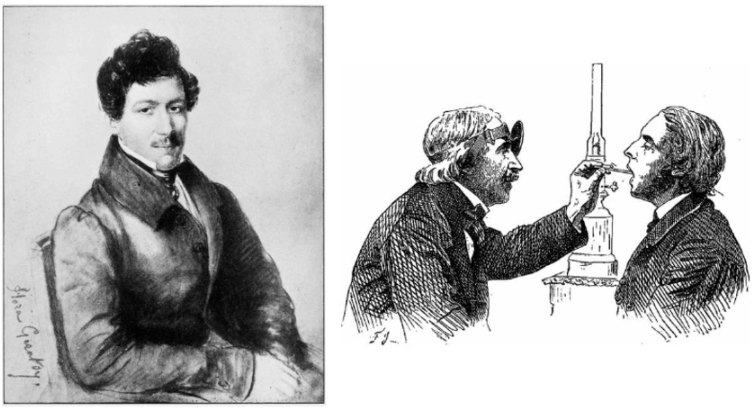
Image 1: Garcia Senior | Image 2: Garcia the younger uses the laryngoscope
Coup de la Glotte
The Coup de la Glotte was fundamental to Garcia’s singing method. However, his descriptions of it are difficult to interpret. Since his own times, it has been questioned and, in some cases, criticized as extremely harmful to the voice. Stark claims that both critics and proponents misunderstood the Coup de la Glotte leading to Garcia’s original conception of it being lost.[26] Researchers still disagree on what Garcia actually intended. Miller and Mason associate it with an explosive onset, similar to a coughing sound, in which air accumulates behind the closed vocal cords, releasing explosively when the air flow is pressed through the closed glottis.[27] Stark and the singing teacher Daniela Bloem-Hubatka claim that this is a misunderstanding of the Coup de la Glotte.[28] I believe Garcia actually intended a firm and, to some extent, explosive vocal onset to minimize the air flow. According to Garcia this would bring out the “ringing” or “brilliant” tone quality that he required. To understand this it is necessary to understand the functioning of the vocal cords.
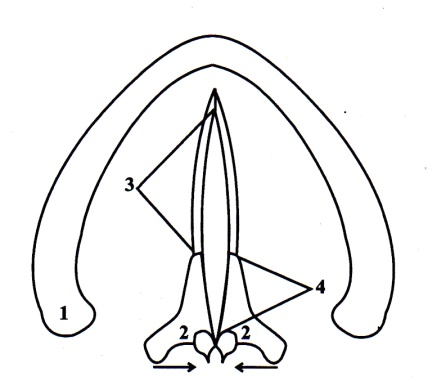
Image 3, 1) thyroid cartilage 2) interarytenoid muscles 3) membranous glottis 4) arytenoid cartilage[29]
The vocal cords consist of two fifths arytenoid cartilages and three fifths membranous glottis. The arytenoid cartilage controls the opening and closing of the membranous glottis. They are able to move extremely fast. The gap between the vocal ligaments is known as the glottis. The air sets the ligament part in vibration and the phonation frequency is controlled by the tension and thickness of the vocal cords.[30] According to Stark there are three ways of closing the glottis in opera singing: aspired, simultaneous, and hard/explosive onsets. Aspired onset means that the phonation begins with air before the glottis is closed. Simultaneous onset obviously means that the phonation starts at the same time as the air hits the glottis and this is the most common in opera singing today. The hard or explosive onset “requires strong adduction with a combination of adductive tension, medial compression, and a stiffening of the vocal folds themselves.”[31] Stark condemns this hard, explosive onset as using harmfully high subglottal pressure and he claims that this is not the same as Garcia’s Coup de la Glotte. He also claims that the Coup de la Glotte totally differs from the three onset types described above.
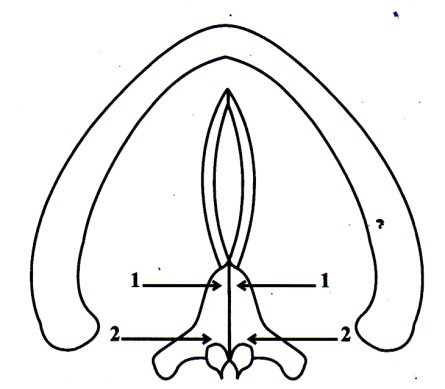
Image 4[32]
According to Stark, a correct Garcia Coup de la Glotte starts with closing the arytenoid cartilages, as shown in Image 4. This results in only the membranous glottis vibrating when the phonation starts. This shortens the glottis during the phonation minimizing the air flow and creating the tone quality that Garcia required. This, according to Stark, is the difference between the Coup de la Glotte and the simultaneous onset, which may be set with full glottal length.[33] Stark claims that when the arytenoid cartilages are not closed tightly enough, the full glottal length would vibrate and create a veiled quality of tone that Garcia wished to avoid.
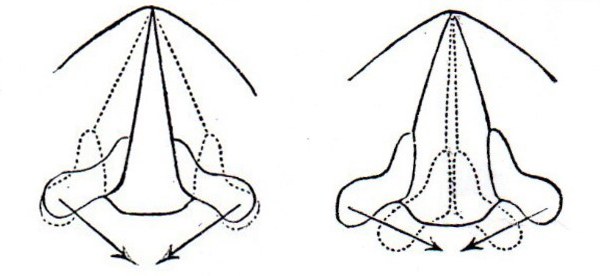
Image 5a & 5b
Images 5a and 5b are Garcia’s pictures. They are not exactly the same as Stark’s. Image 3a shows the opened glottis and Image 3b shows the closed glottis without explaining which part is vibrating during the phonation. However, in 1855, Garcia indicated an explanation similar to Stark’s: “This deep contact, which continues even after the apophyses no longer partake in the vibrations, gives a deep tension to the membranes, increases the depth of their contact, and, as a necessary consequence, augments the resistance they present to the air.”[34] To my understanding, Garcia explains that the arytenoid cartilages are not vibrating during the phonation, although he does not say here if this is unique to the case of Coup de la Glotte. In 1847, before his invention of the laryngoscope, Garcia explains that the glottis lips may still vibrate “either when the posterior extremities are put into contact (by bringing together of the internal processes of the arytenoids), or when these extremities remain separated. In the first case, the sounds are emitted with all the brilliance possible; in the second, the voice takes a dull character.”[35]
As already stated, Stark and Bloem-Hubatka condemn the execution of the Coup de la Glotte in a way that involves explosiveness in the onset, insisting that this was not Garcia’s intention. Bloem-Hubatka claims that if the vocal cords are pressed together so that the air becomes compressed behind, this causes an explosion of the air, and that is a wrongly executed Coup de la Glotte.[36] However, I believe there is some evidence indicating that Garcia actually intended this explosiveness, even if the audible air explosion was not his first aim. Sundberg claims that when the adduction is complete and air accumulates behind the vocal cords before the air pressure starts, you get an explosive onset, also known as Coup de la Glotte.[37] This is what Garcia actually expresses in 1847:
It is necessary to prepare the stroke of the glottis by closing it, which stops and momentarily accumulates some air in the passage; then, much as a rupture operates as a means of relaxation, one opens it with an incisive and vigorous stroke, similar to the action of the lips in pronouncing the consonant p. This stroke of the throat also resembles the articulation of the consonant k.[38]
And in New Treatise 1872:
The glottis is prepared for articulation […] by closing it, which causes a momentary accumulation of air below; and it is then opened by a sudden and vigorous stroke, similar to the action of the lips when strongly emphasizing the letter P.[39]
Garcia emphasized the importance of practising directly on the vowels to achieve the exact and correct Coup de la Glotte.
Some masters recommend the use of the syllables Pa, La, Ma &c., in order to acquire precision in striking notes; but in our opinion, this plan […] has the disadvantage of merely disguising the faulty articulation of the glottis, without possessing any power whatever of correcting it.[40]
In Hints on Singing 1894, he even claims that to achieve Coup de la Glotte, the tone should be slightly “hit” by a vowel. It is the same mechanism as in coughing, but with less force. On the question of how, in practical terms, one may obtain the sensation of Coup de la Glotte he answers: “By coughing almost imperceptibly. The glottis then closes and opens; through these actions we feel it distinctly”.[41] He admits that, even though they differ in force, the impulse of coughing and the execution of the Coup de la Glotte are essentially the same.
The stroke of the glottis is somewhat similar to the cough, though differing essentially in that it needs only the delicate action of the lips and not the impulse of the air. The lightness of movement is considerably facilitated if it be tried with the mouth shut. Once understood, it may be used with the mouth open on any vowel.[42]
Garcia’s instruction suggests the same action as Sundberg associates with the Coup de la Glotte. The adduction is completed before the air pressure starts and the air is accumulated behind the vocal cords. This requires force in the adduction muscles to resist the air pressure. The vigorous stroke then creates high subglottal pressure to break through the adduction muscles.[43] Garcia’s texts indicate that he knew this and was targeting for it. Most probably, his purpose was strong adduction that creates strong glottal resistance and a minimum of air flow. He wanted to minimize the risk of unnecessary air escaping during the phonation. Garcia disliked what he considered as veiled or dull tones caused by escaping air. He claimed that airiness produced a dull tone character, which he believed would fatigue the lungs.[44] In 1872 he warns: “Pupils, however, must scrupulously avoid preceding these with an h, or aspiration.”[45] In 1894, he adds: “if the glottis is imperfectly closed, and a slight escape of air unites the explosions, the impressions upon tympanum are blunted, the sound being then veiled.”[46] Similarly, back in 1855, he explains that: “according as the glottis partially or entirely closes the passage between the explosions [of the air], it produces veiled or brilliant sounds”.[47] Garcia believed that, in the long run, the aspired onset would fatigue the voice and that singers should take especial care to master the Coup de la Glotte correctly. In Hints on Singing, he asserts that continuous leakage “is caused by the lips of the glottis being imperfectly closed. The ring can be obtained by attacking with a sharp stroke of the glottis every sound […] in Italian vowels.”[48]
I believe Garcia’s main goal was to minimize the air flow and to define a technique for strong adduction and glottal resistance. However, the accumulation of air behind the vocal cords may explode in an audible stroke. The stroke may be executed to varying degrees of hardness. The question is what degree was perfect to Garcia. He probably did not intend it to be audible but, still, it would need to be strong enough to break through the adduction muscles. This explosion of air may sometimes be heard in recordings of Garcia-Marchesi pupils, like Nellie Melba when she sings the introduction part to La Traviata. It may even be seen, using a sonic visualiser, as in Image 6. Nellie Melba attacks the tone with an audible stroke that I believe is a Coup de la Glotte in the form that she would have been taught it by Marchesi, who learnt it from Garcia.
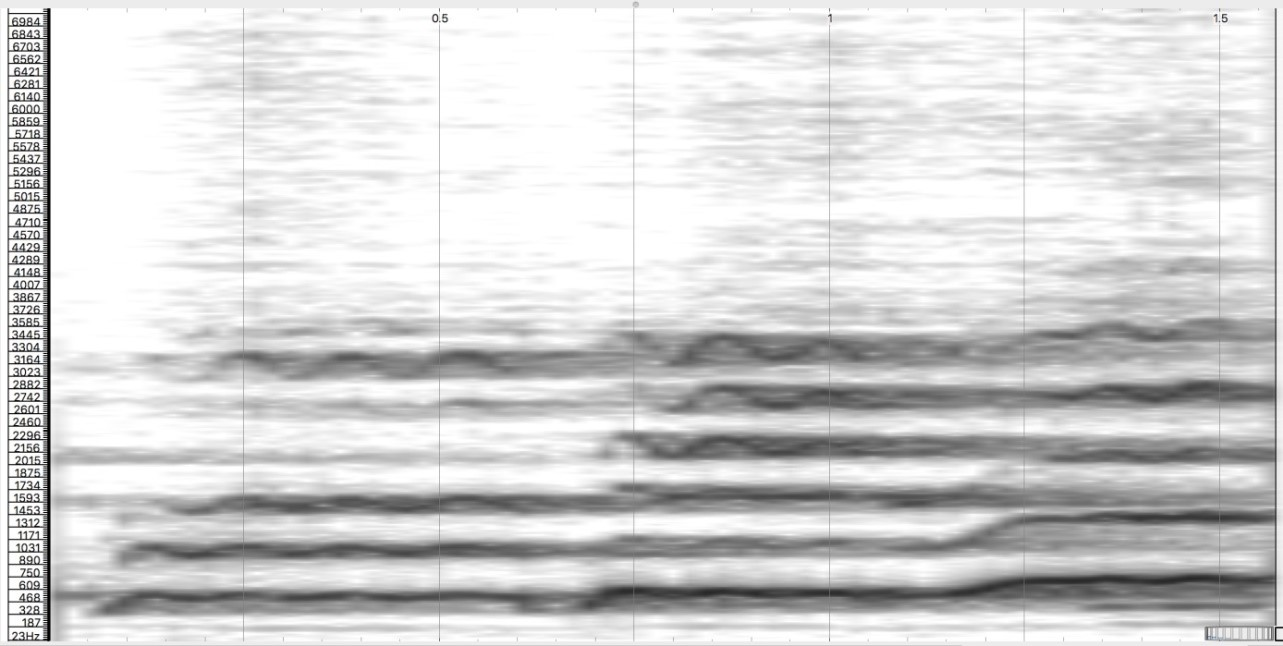
Image 6
This image starts with an obvious Coup de la Glotte, the small upward trace just at the beginning, and there is one more shown right after 0.5 seconds. The second one is separated from the first tone, suggesting a new onset with accumulated air behind the vocal cords, before it explodes again in the small upward contour. The image even shows a third one, although without a totally separated new onset. This may be compared with sonic visualisations of a modern singer, who sings a five tone scale from a’–e’’ with one onset at a’, first with accumulated air and a small explosion as shown in image 7, and then without as shown in image 8.
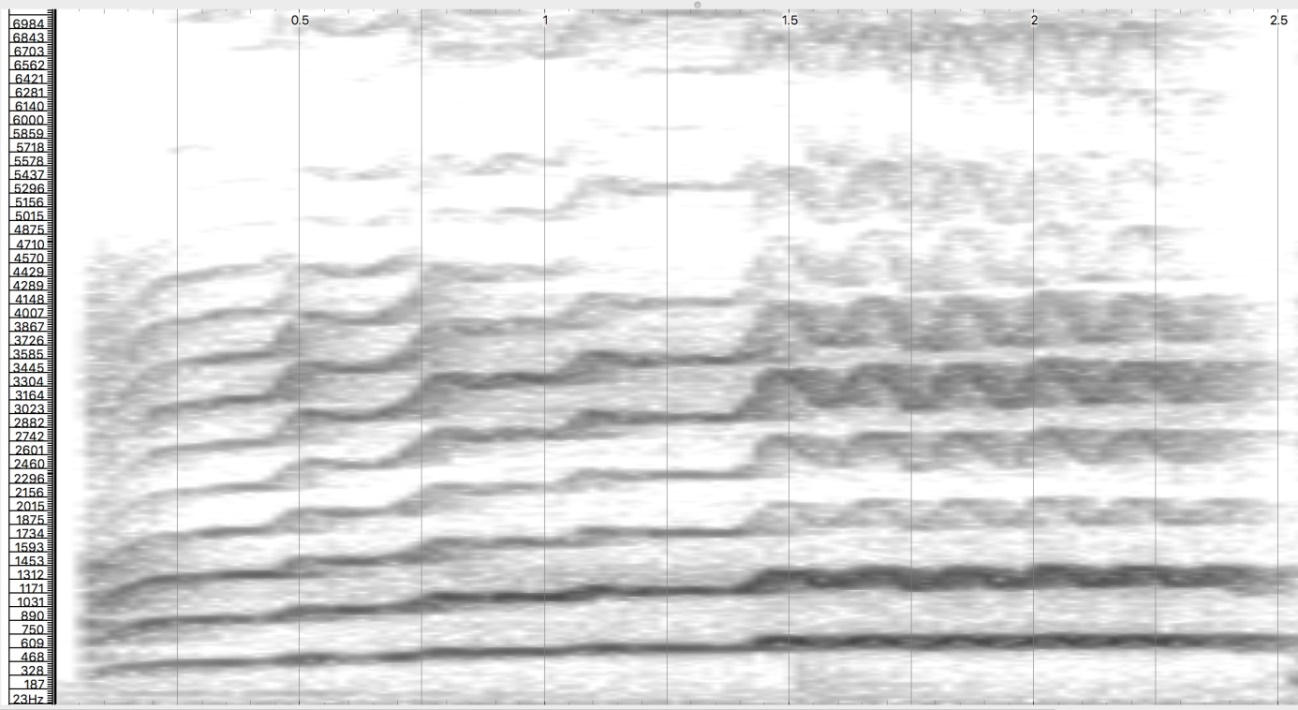
Image 7
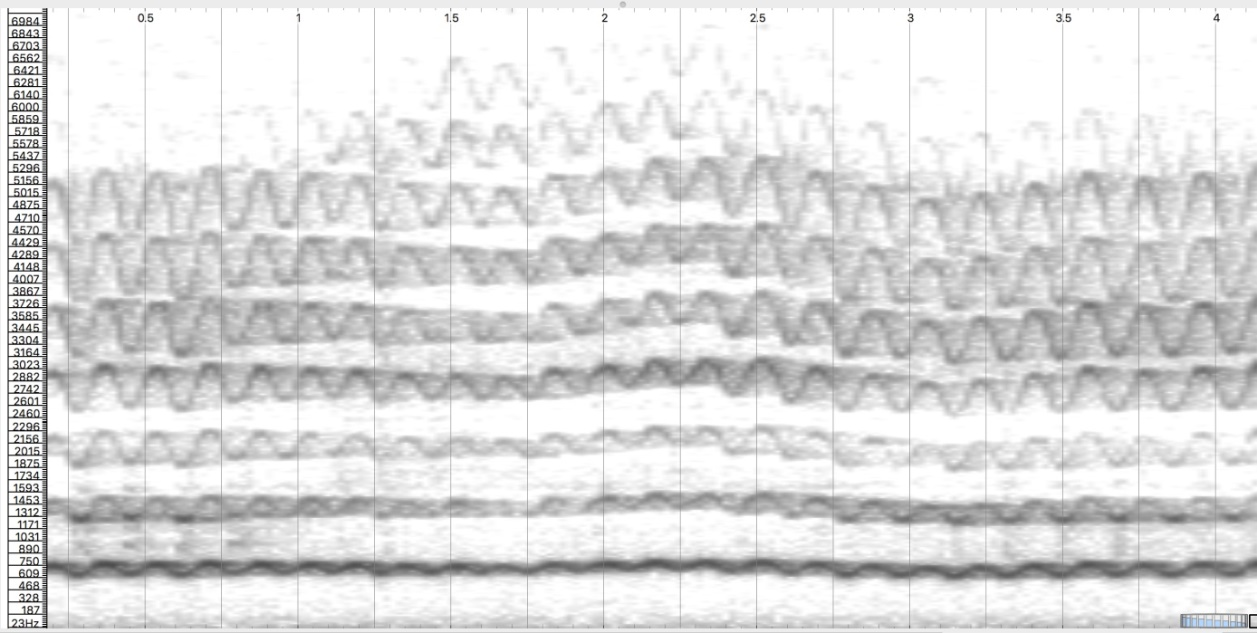
Image 8
There is an obvious difference in the tone onset between the examples with and without Coup de la Glotte. When the Coup de la Glotte is executed, there is an upward trace in the tone onset. Although it is not as sharp as in the Nellie Melba example, it still clearly differs from the simultaneous onset, where there is no visible uphill or anything that may be recognized as intruding sound.
In practical terms, it may be difficult to grasp what Garcia actually intended. His instructions are, to some extent, contradictory. He warns against “stroke of the chest”, which he likens to coughing, saying that this creates a stiffed, uncertain tone. However, in the same text he claims that the Coup de la Glotte still uses the same mechanism as in coughing, and to understand this mechanism one should cough carefully.[49] If the Coup de la Glotte is executed forcefully, a scratching sound may even appear when the airflow starts, and the tone may stiffen and even become false. However, if it is executed too softly, there tends to be no difference between a Coup de la Glotte and a simultaneous onset. It is difficult to manage to execute it with the perfect degree of firmness, using a minimum of air flow, but not with as hard a stroke as in coughing. When comparing the experiments with the recording of Nellie Melba it is obvious that her firm onset is also sometimes audible.
Larynx position for the Voix Blanche
Garcia’s designation of timbres is a complex definition of how to use larynx positions in order to create different emotions in the singing voice. Garcia defined these positions as Voix Blanche (clear voice, high larynx position) and Voix Sombre (dark voice, lowered larynx position). He did not invent the terms himself, although he extended the catalogue of how to use these larynx positions. To Garcia, Voix Blanche and Voix Sombre played a major part of the complexity of the timbre.[50]
Before the nineteenth century, the vocal schools did not talk about larynx positions and the evidence indicates that opera singers did not fix the larynxes in any particular position. Their larynx followed the tones up and down.[51] But by Garcia’s time, some tenors did experiment with a fixed lowered larynx, which got the name Voix Sombre. According to Susan Rutherford and Gregory W. Bloch, the purpose was to create a virile, heroic sound. The phenomenon already appeared in the 1790s, although it was not fully established until approximately the mid-nineteenth century.[52] The earlier, higher larynx position that still was standard until approximately the 1830s was then named Voix Blanche so as to distinguish it from the new technique, Voix Sombre. The best known and mythologized story of the break-through of the lowered larynx is when the tenor Louis Gilbert Duprez (1806–96) caused a sensation in 1837 at the Grand Opera in Paris with his high c delivered with a low larynx. Duprez was observed by the contemporary researchers Paul Diday and Joseph Pétrequin, who presented their observations in 1839.[53] Half a year later, Garcia presented the larynx positions Voix Blanche and Voix Sombre in his 1840 thesis. He claimed in a letter to the academy that he had known the new technique of fixed lowered larynx and had taught it since 1832.[54] According to Bloch, Diday and Pétrequin coined the terms Voix Blanche and Voix Sombre but it was Garcia’s achievement to thoroughly establish them.[55] During the second part of the nineteenth century, the lowered larynx, became increasingly indispensable and gradually replaced the higher and flexible positions. By around 1900, the higher larynx position had vanished and a fixed low larynx was the new central concept. Today it is universally the case that most opera singers prefer the fixed lowered larynx position.[56]
Garcia knew very well how the vocal reflection in the pharynx functions. His explanations are similar to those of the modern researcher Sundberg. The voice is reflected and echoed by the Pharynx, the vocal tube – an elastic and flexible cavity.[57] Garcia calls it a “highly-elastic pipe.”[58] To grasp the action of the pharynx muscles, the yawning activity lowers the larynx and raises the soft palate and the opposite actions occur when we are swallowing.[59] The pharynx starts straight though forming a curve at the arch of the palate. This forms the vocal tube that ends in the mouth. The vocal tube is flexible and the length is decided by the larynx and soft palate. The larynx and the soft palate move in opposite directions. When the larynx is raised, the soft palate falls to a low position which provides a short throat, or short reflecting tube, and is referred to as Voix Blanche by Garcia. If the larynx is lowered, the soft palate is raised, which provides a long throat, or long reflecting tube, and is referred to as Voix Sombre by Garcia. The difference is shown in Images 9a and 9b.
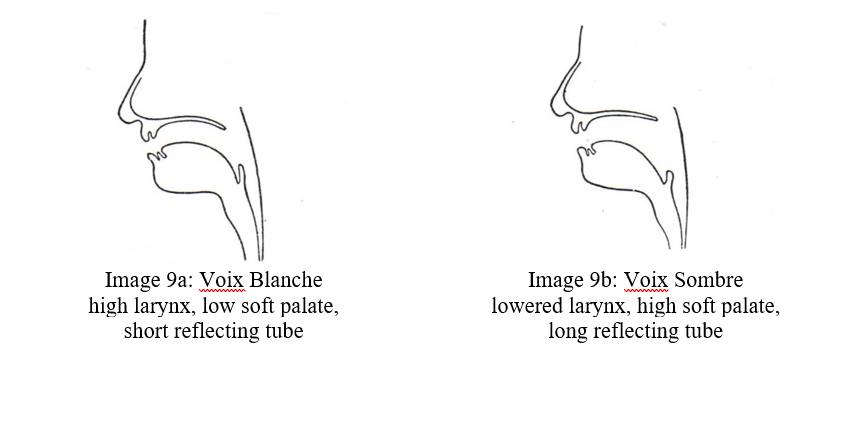
The images show that the shape of the tube in Voix Blanche is more curved than in the Voix Sombre. Garcia noticed that the short gently-curved shape produces a bright timbre and the lengthened and strong-curved form produces a darker sound.[60] The shape of the pharynx affects the formant frequencies and, consequently, the sound character of the voice. According to Sundberg, the formant frequencies are decided by the length and shape of the vocal tube. The shorter vocal tube the higher the formant frequencies.[61] Moreover, when the soft palate is placed in a high position, as in Garcia’s Voix Sombre, the connection between pharynx and the nose cavity is closed. When the soft palate is lowered, as in Garcia’s Voix Blanche, it is open.[62] Even though Garcia did not use the words formant frequency, his texts show an awareness of the phenomenon. Garcia claims that a short vocal tube produces brilliancy in the voice, which Sundberg explains with reference to high formant frequencies. The long vocal tube produces, in Garcia’s terms, roundness to the voice, which Sundberg explains as a predominance of lower formant frequencies.[63] Image 10 shows how the formant frequencies obviously change when the larynx changes position in one long note on f’’.

Image 10
The image starts with a low larynx; the singer then changes to a high larynx, without resetting the tone, right before 1.5 seconds, and then back again between 2.5–3 seconds. As the image shows, the higher formant frequencies rise, the seventh formant becomes more resonant and there even appears one further formant when the larynx is raised. Also the base note, f’’ is pitched slightly higher when the larynx is raised.
According to Garcia, each timbre ought to be modified in relation to the emotion which is going to be expressed. Voix Sombre is suitable to sad feelings, such as grief, lamentation, suffering, while Voix Blanche is appropriate to joy, happiness, vivacity. However, if exaggerated or used in conjunction with the wrong emotions, the Blanche can become shriek and shrill and the Sombre, dull and even hoarse.[64]
The lowered larynx is definitely an advantage when seeking to increase voice volume, although at the expense of flexibility.[65] Bloch translates the essence of how Diday and Pétrequin interpreted the advantages and disadvantages of the two larynx positions:
The darkening gives the singing more energy, but it takes away much of its agility; the voix blanche has less force, but gains the advantage whenever vivacity becomes indispensable. The first has a slow, solemn quality; the second has more facility in its manner, more delicacy in its forms. The sound of one is full, but veiled; the other is ringing but a little thin. One transports and dominates with power; the other seduces and captivates with its flexibility*.*[66]
Diday and Pétrequin described how the Voix Sombre gives more energy and volume, though at the expense of flexibility. They characterised the Voix Sombre as slower, more serious and grave and warned that the timbre easily gets veiled. They even believed that it is exhausting and dangerous to the voice, while the Voix Blanche, though less powerful, has the advantage of flexibility, agility and a more ringing timbre.[67] Since the focus shifted from vocal agility to dramatic long lines, and the tessitura was lowered again after being on top in the 1830s,[68] the singers benefited more from Voix Sombre, leading to the decline of the Voix Blanche. However, as Diday and Pétrequin claimed, these gains came at the expense of flexibility. Ornaments and fast coloraturas tend to flow more easily with a high larynx. The phenomenon of the Voix Blanche actually still exists, although very rarely, and may be observed in the performance of some high coloratura sopranos. Sundberg claims that some high sopranos still shorten their vocal tube by raising their larynx in the high register, although it is unfashionable and not very common.[69] Miller claims this occurs especially in the case of some French and Italian coloratura sopranos and accounts for the fact that their extremely brilliant timbre is often perceived as shrill to modern ears.[70]
It seems likely that the higher larynx position facilitates the highest tessitura. In the vocal experiments carried out as part of the research, one of the two participating coloraturas consciously raises and lowers her larynx with the tessitura. The other one raises her larynx in the upper part of the second octave, around A5, though she does it unconsciously. For the purposes of the experiment, they deliberately tried holding their larynx fixed in a lowered position. When they reached approximately A5 they both found it uncomfortable and wanted to raise it. They were able to hold the larynx fixed in this low position even further, until C6–C#6, although they found doing so unpleasant. Both their normal ranges extend to at least A6, but not with a fixed lowered larynx. I tried this experiment with a mezzo soprano as well. Her tone range extends to C6. She raised her larynx slightly at B5, at her upper tone limit. The outcome of this experiment suggests that a short vocal tube, a high larynx position facilitates the highest tone range. The standard of fixed low larynx technique caused to some extent the loss of flexibility and agility. It may, however, very well cause even the loss of the highest tone range to high soprano voices.
Conclusion
Stark and Austin claim that Garcia was an eager proponent of, in particular, the lowered larynx, and that firm vocal onset together with a fixed lowered larynx were his main ideas of good voice production.[71] However, I believe this is a misunderstanding. Miller explains that it was not Garcia himself, but his later successor, Julius Stockhausen, who eagerly campaigned for fixed lowered larynx in publications dating from 1886 and 1887. Stockhausen’s ideas have been mixed up with Garcia’s.[72] Garcia himself did not favour either Voix Blanche or Voix Sombre over its counterpart. To him, they were technical tools, used to modify the emotional quality of the performance, and ones that he valued equally.[73] Under the headline ‘On timbre’ in his Treatise 1872, Garcia gives several examples of when he preferred the different timbres. As was seen, he even claims that if the timbres are incorrectly used, the Blanche becomes shrill and the Sombre becomes hoarse.[74]
The experimental component of this research suggests that the technique of Coup de la Glotte may function better when used in conjunction with the technique of Voix Blanche. The glottis filming indicates that Coup de la Glotte tends to constrict and narrow the vocal tube. The pharynx is pressed inwards and the larynx tends to place itself in a slightly higher position.
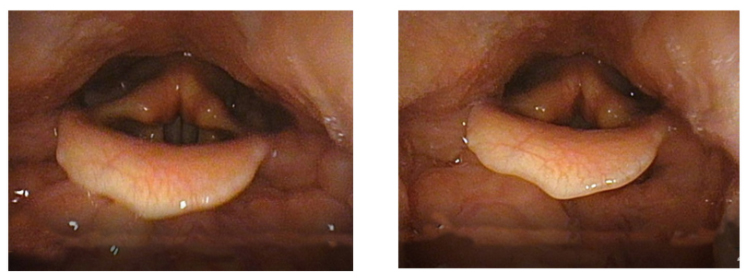
Image 11 & 12: The filming was made by Inselspital Bern
Image 11 illustrates the onset of F5 without Coup de la Glotte. Image 12 illustrates the exact moment of onset of F5 with Coup de la Glotte. When the onset is executed whith Coup de la Glotte the pharynx muscles presses inwards, narrowing the vocal tube. The constriction even seems to push the larynx slightly upwards. It may be possible to train the larynx to stay fixed in low position when executing Coup de la Glotte, although this experiment suggests that it naturally rises. This indicates that the technique of Coup de la Glotte best suits the high larynx position, not a fixed lowered larynx which Stark and Austin claim to be Garcia’s intention.[75] The Coup de la Glotte causes a slim, narrow vocal tube. The wideness of the vocal tube affects the formants and, consequently, the timbre. Garcia claimed that the Coup de la Glotte gives stability to the tone and phrase. This narrow timbre, as illustrated in the middle of image10, was probably his vocal ideal.
I suggest it was not a coincidence that Garcia’s techniques of Coup de la Glotte and Voix Blanche gradually vanished during the same period that vocal flexibility declined and the vogue for strong voices increased. Garcia’s techniques were old-fashioned and he certainly did not like the new focus on voice resonance. He considered the new declamatory style as overly harsh to the voice and he claimed that it requires more vocal maturity than many of the singers had. Garcia’s techniques aimed to facilitate the agility of the older vocal aesthetic. Even as late as 1894, his exercises were focussed on improving agility, coloraturas and embellishments. The pupils of Garcia and, possibly, of Marchesi were the last opera singing generation to use the short vocal tube. They were also the last singers who consciously used the Coup de la Glotte as part of their technical resource. Some of them, such as Nellie Melba, Selma Kurz, Blanche Marchesi and Emma Eames, may still be heard on recordings from the beginning of the twentieth century. After them, these techniques became extinct but research of the kind presented here can give us a tantalising flavour of what Garcia’s vocal ideal might have sounded like in practice.
-
James Stark, Bel Canto. A History of Vocal Pedagogy, University of Toronto Press, 3rd edn., Toronto Buffalo/London, 2008, pp. 3–44; See Daniela Bloem-Hubatka, The Old Italian School of Singing. A Theoretical and Practical Guide, Jefferson, McFarland & Company, North Carolina/London, 2012, pp. 5–7. Bloem-Hubatka defines Garcia as a re-interpreter of Bel Canto singing. ↩︎
-
Philip A Duey, Bel Canto in its Golden Age. A Study of its Teaching Concepts, King’s Cross Press, Columbia University, New York, 1951, pp. 4–7, 53, 73–89. ↩︎
-
For more reading, see Susan Rutherford, The Prima Donna and Opera, 1815–1930, Cambridge University Press, Cambridge/New York, 2006, pp. 90–97; Mary Ann Smart, “Roles, reputations, shadows, singers at the Opéra, 1828–1849”, in David Charlton, ed., The Cambridge Companion to Grand Opera, Cambridge University Press, Cambridge/New York, 2003, pp. 108–128, especially pp. 117–120; Richard Miller, National Schools of Singing. English, French, German, and Italian Techniques of Singing Revisited, The Scarecrow Press 3rd edn Laham Maryland/Oxford, 2002, pp. 14–19; Robert Toft, Bel Canto. A Performer’s Guide, Oxford University Press, Oxford/New York, 2013, p. 3; Stark, Bel Canto, pp. 91–93. ↩︎
-
Manuel Particio Rodriguez Garcia, Garcia’s New Treatise of the Art of Singing. A Compendious Method of Instruction, with Examples and Exercises for the Cultivation of the Voice, Oliver Ditson Company, Boston 1872; Manuel Particio Rodriguez Garcia, Hints on Singing. Translated from the French by Beata Garcia, E. Ascherberg & Co., London/ New York, 1894; James Stark, “Garcia in Perspective: His Traité After 150 Years” in Journal of Research in Singing 1991 Vol. 15. No 1, pp. 2–55, especially pp. 26–27, 39–42. ↩︎
-
David Mason, “The teaching (and learning) of singing”, in John Potter, ed., The Cambridge Companion to Singing, Cambridge University Press, Cambridge, 2000, pp. 204–220, especially p. 213. ↩︎
-
David Lawton, “Ornamenting Verdi’s Arias. The Continuity of Tradition” in Alison Latham and Roger Parker ed., Verdi in Performance, Oxford University Press, Oxford/New York, 2010, pp. 55–84, especially pp. 56–64. ↩︎
-
Manuel Particio Rodriguez Garcia, Hints on Singing, pp. v–vii. ↩︎
-
Donald Paschke, “Manuel Garcia: Method and Controversy”, in Journal of Research in Singing, 1987, pp 51–56, especially p. 51. ↩︎
-
Miller, National Schools of Singing, p.2; Mason, “The teaching (and learning) of singing”, pp. 211–213. ↩︎
-
Stark, “Garcia in Perspective”, p. 28; Stephen Austin, "The Attack on the coup de la glotte ", in Journal of Singing, May/June 2005, Vol. 61, no. 5, pp. 525–529; Robyn Cathcart, The Singing School of Manuel Garcia II, University of Victoria BC, Canada, 2013, Diss. p. 34. ↩︎
-
Stark, Bel Canto; Stark, “Garcia in Perspective”. ↩︎
-
Mason, “The teaching (and learning) of singing”, p. 212. ↩︎
-
Garcia, Garcia’s New Treatise. ↩︎
-
Manuel Particio Rodriguez Garcia, “‘Observations on the Human Voice.’ By Manuel Garcia, Esq. Communicated by Dr. Sharpey, Sec. R. S. Received Marsh 22, 1855”, in Proceedings of Royal Society of London, 1855, Vol. 7, pp. 399–410. ↩︎
-
Manuel Particio Rodriguez Garcia, Hints on Singing. Translated from the French by Beata Garcia. E. Ascherberg & Co., London/New York, 1894. ↩︎
-
Donald V. Paschke, A complete treatise on the art of singing, part two by M. García II. Second part, complete and unabridged, the editions of 1847 and 1872 collated, ed. and transl. by Donald V. Paschke. Reprint of the 1872 edition. Da Capo Press, New York, 1975. ↩︎
-
Beth Williams, “Traditional Italian lineages of vocal pedagogy, including Marchesi/Garcia influences, in Australia (1850–1900)”, in Context, no 18, 2000, pp. 25–36, especially p. 27; See also Robyn A Stevens “The García Family: The Pedagogic Legacy of Romanticism’s Premiere Musical Dynasty”, in Journal of Singing May/June 2009, Vol. 65, no. 5, 531–537. ↩︎
-
Naomi André, Voicing Gender. Castrati, Travesti, and the Second Woman in Early-Nineteenth-Century Italian Opera. Indiana University Press, Bloomington, Indianapolis, 2006, pp. 37–39. ↩︎
-
Barbara E. Burdick, A comparative study of registration in the soprano and tenor voices, College-Conservatory of Music, University of Cincinnati 1993, Diss, p. 186. ↩︎
-
Johan Sundberg, Röstlära. Fakta om rösten i tal och sång, third ed., second printing, 2007. ↩︎
-
Manuel del Pópulo Vicente Garcia, Exercises an Method for Singing, with an Accompaniment, for the Piano Forte, composed and dedicated to Miss Frances Mary Thompson, by Manuel Garcia. T. Boosey & Co., London, 1824; for more reading of Garcia the older, see James Radomski, Manuel Garcia (1775–1832). Chronicle of the Life of a bel canto Tenor at the Dawn of Romanticism, Oxford University Press Oxford/New York, 2000; James Vincent Radomski, The life and works of Manuel del Pólpulo Vicente Garcia (1775–1832): Italian, French and Spanish opera in early nineteenth-century romanticism. Vol. I and II, University of California, Los Angeles 1992, Diss. ↩︎
-
However, Margaret Kennedy-Dygas claims that Garcia was not the first to use this kind of laryngeal mirror, Margaret, Kennedy-Dygas, “Historical Perspectives on the ‘science’ of Teaching Singing Part III: Manuel Garcia II (1805–1906) and the Science of Singing in the Nineteenth Century”, in Journal of Singing March/April 2000, vol. 56, No 4, pp. 23–30, here p. 26. ↩︎
-
For further reading concerning Garcia the younger, see Stark, Bel Canto. ↩︎
-
Rutherford, The Prima Donna and Opera, pp. 90–97; Burdick, A comparative study of registration in the soprano and tenor voices, pp. 2–4; Margaret, Kennedy-Dygas, “Historical Perspectives” pp. 24–25. ↩︎
-
Stark, “Garcia in Perspective”, p. 4. ↩︎
-
Stark, Bel Canto, pp. 11–32; Stark, “Garcia in Perspective”, pp. 28–32; See Teresa Radomski, “Manuel Garcia (1805–1906). A Bicentenary Reflection”, in Australian Voice. The official journal of the Australian National Association of Teachers of Singing, December 2005 Vol. 11, pp. 25–41, here pp. 14–15. ↩︎
-
Miller, National Schools of Singing, p.2; Mason, “The teaching (and learning) of singing”, pp. 211–213. ↩︎
-
Stark, “Garcia in Perspective”, pp. 11–14; Bloem-Hubatka, The Old Italian School of Singing, pp. 21–22. ↩︎
-
Picture and annotations from Stark Bel Canto, p. 9. ↩︎
-
Sundberg, Röstlära, p. 72. ↩︎
-
Stark, Bel Canto, pp. 12 & 21. ↩︎
-
Stark, Bel Canto, p. 9. ↩︎
-
Stark, Bel Canto, pp. 11–32; Stark, “Garcia in Perspective”, p. 5, pp. 11–14, 28–32. ↩︎
-
Garcia, “Observations on the Human Voice”, p. 408. ↩︎
-
Garcia 1847, cited by Stark, Bel Canto, p. 11. ↩︎
-
Bloem-Hubatka, The Old Italian School of Singing, pp. 21–22. ↩︎
-
Sundberg, Röstlära, p. 78. ↩︎
-
Garcia 1847, cited by Stark, Bel Canto, p. 13. ↩︎
-
Garcia, Garcia’s New Treatise, p. 11. ↩︎
-
Ibid., p. 11. ↩︎
-
Garcia, Hints on Singing, p. 5. ↩︎
-
Ibid., pp. 13–14. ↩︎
-
Sundberg, Röstlära, pp. 24–28, pp. 52–83. ↩︎
-
Garcia, cited by Donald V. Paschke, A complete treatise on the art of singing, part two by M. García II. Second part, complete and unabridged, the editions of 1847 and 1872 collated, ed. and transl. by Donald V. Paschke. Reprint of the 1872 edition. Da Capo Press, New York, 1975, p. 152. ↩︎
-
Garcia, Garcia’s New Treatise, p. 44. ↩︎
-
Garcia, Hints on Singing, p. 7. ↩︎
-
Manuel Particio Rodriguez Garcia, “‘Observations on the Human Voice.’ By Manuel Garcia, Esq. Communicated by Dr. Sharpey, Sec. R. S. Received Marsh 22, 1855”, in Proceedings of Royal Society of London, 1855, Vol. 7, pp. 399–410, especially p. 410. ↩︎
-
Garcia, Hints on Singing, p. 15. ↩︎
-
Garcia, Garcia’s New Treatise, p. 11; Garcia, Hints on Singing, p. 5. ↩︎
-
Toft, Bel Canto, pp. 85–86. ↩︎
-
Richard Wistreich, “Reconstructing pre-Romantic singing technique”, In John Potter, ed., The Cambridge Companion to Singing. Cambridge University Press, Cambridge, 2000, pp. 178–191, here p. 180. ↩︎
-
Susan Rutherford, “Voices and singers”, in Nicholas Till, ed., The Cambridge Companion to Opera Studies, Cambridge University Press, Cambridge/New York, 2012, pp. 117–138, here p. 131; See George W. Bloch, “The pathological voice of Gilbert-Louis Duprez”, in: Cambridge Opera Journal, 2007, vol. 19, no. 1 Cambridge University Press, pp. 11–31, here pp. 14–15. ↩︎
-
Bloch, “The pathological voice of Gilbert-Louis Duprez”, p. 14; Miller National Schools of Singing, pp. 110–112, claims that Duprez’ technique corresponded to the Italian school. The individual incidence illustrates a new increasing international standard. ↩︎
-
Paschke, A complete treatise on the art of singing, part two by M. García II, pp. xxx–xxxii ↩︎
-
Bloch, “The pathological voice of Gilbert-Louis Duprez”, p. 18. ↩︎
-
Mason, “The teaching (and learning) of singing”, p. 212; George W. Bloch, “The pathological voice of Gilbert-Louis Duprez”, in: Cambridge Opera Journal, 2007, vol. 19, no. 1 Cambridge University Press, pp. 11–31, here p. 17; Miller, National schools of singing, p. 85. ↩︎
-
Garcia, Garcia’s New Treatise, p. 5. ↩︎
-
Garcia, Garcia’s New Treatise, p. 7. ↩︎
-
Garcia, Hints on Singing, p. 11; Garcia, Garcia’s New Treatise, 1872, p. 7. ↩︎
-
Garcia, Garcia’s New Treatise, p. 8; Garcia Hints on Singing, p. 11, 45. ↩︎
-
Sundberg, Röstlära, p. 69. ↩︎
-
Sundberg, Röstlära, p. 35. ↩︎
-
Sundberg, Röstlära, pp. 143–163. ↩︎
-
Garcia, Garcia’s New Treatise, pp. 6, 44. ↩︎
-
Sundberg, Röstlära, pp. 154–155; Bloch, “The pathological voice of Gilbert-Louis Duprez”, pp. 15–17; Stark, Bel Canto, pp. 151–152. ↩︎
-
Bloch, “The pathological voice of Gilbert-Louis Duprez”, p. 15. ↩︎
-
Bloch, “The pathological voice of Gilbert-Louis Duprez”, pp. 15–17. ↩︎
-
Rutherford, The Prima Donna and Opera, p. 90; Rutherford, “Voices and singers”, p. 131. ↩︎
-
Sundberg, Röstlära, pp. 163–164. ↩︎
-
Miller, National Schools of Singing, pp. 83–84, p. 143. ↩︎
-
Stark, "Garcia in perspective, pp. 42–44; Austin, ‘The voce chiusa’ in Journal of Singing March/April 2005. Vol. 61, No. 4, pp. 421–426, here p. 422 claims, that Garcia advocated a fixed lowered larynx, though as evidence he gives quotations of Stockhausen. ↩︎
-
Miller, National Schools of Singing, p. 85. ↩︎
-
See Paschke, A complete treatise on the art of singing, part two by M. García II, p. lvii. ↩︎
-
Garcia, Garcia’s New Treatise, p. 6, pp. 69–71; See Garcia, Hints on Singing, p. 45. ↩︎
-
Stark, Garcia in Perspective, pp. 42–44. ↩︎